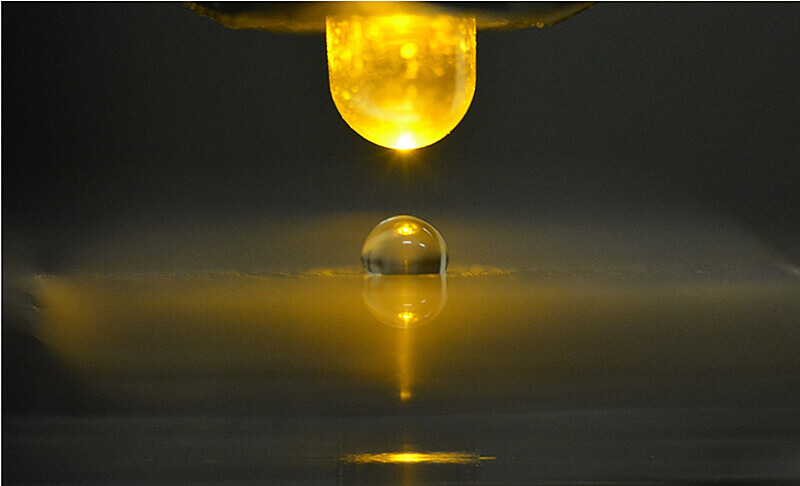April 28, 2020
Color-measuring device for drug development, manufacturing moves closer to market
 A Purdue University teams uses a sessile-droplet approach as part of a method to measure chemical concentrations. (Image provided)
A Purdue University teams uses a sessile-droplet approach as part of a method to measure chemical concentrations. (Image provided)
WEST LAFAYETTE, Ind. – A method using the color intensity of light to measure chemical concentrations soon may help speed the processes for developing medications, printers, and other products.
A team from Purdue University created the new approach for using a light-sensitive device to measure the concentration of chemicals used in applications such as biological research and the manufacturing of consumer goods and food products.
“Our concept significantly reduces the complexities associated with performing colorimetric analysis at the smaller scales necessary for research and production,” said Justin Weibel, a research associate professor in Purdue’s College of Engineering. “Our sessile-droplet approach allows for passive mixing by leveraging its intrinsic flow properties. The adjustable volume of a droplet allows for a relatively simple path to miniaturization.”
Colorimetric reactions include mixing a reagent with a droplet of sample quickly enough to cause a reaction while also producing a measure of sample concentration before these aqueous samples evaporate. The method created by Purdue researchers allows for mixing to occur two orders of magnitude faster than conventional plates used for the process.
“Current state-of-the art colorimetric methods require thorough mixing of the sample and the reagent, and an approximately five-minute reaction time to take the measurement,” said Aditya Chandramohan, a Purdue alumnus and senior engineer at Sandia National Laboratories. “Furthermore, miniaturization efforts require increasingly complex fabrication approaches to reduce the size of wells to accommodate lower volumes of liquid.”
Colorimetry devices are used to monitor the growth of a bacterial or yeast culture, testing water quality, and measuring the concentrations of hemoglobin in blood. They can also be used to measure and monitor the color in various foods and beverages.
The team worked with the Purdue Research Foundation Office of Technology Commercialization to patent the technology. The office recently moved into the Convergence Center for Innovation and Collaboration in Discovery Park District, adjacent to the Purdue campus.
The creators are looking for partners to commercialize their technology. For more information on licensing this innovation, contact D.H.R. Sarma of OTC at dhrsarma@prf.org.
The Purdue team’s work was presented in ACS Omega.
About Purdue Research Foundation Office of Technology Commercialization
The Purdue Research Foundation Office of Technology Commercialization operates one of the most comprehensive technology transfer programs among leading research universities in the U.S. Services provided by this office support the economic development initiatives of Purdue University and benefit the university's academic activities through commercializing, licensing and protecting Purdue intellectual property. The office is managed by the Purdue Research Foundation, which received the 2019 Innovation and Economic Prosperity Universities Award for Place from the Association of Public and Land-grant Universities. The Purdue Research Foundation is a private, nonprofit foundation created to advance the mission of Purdue University. Contact otcip@prf.org for more information.
About Purdue University
Purdue University is a top public research institution developing practical solutions to today’s toughest challenges. Ranked the No. 6 Most Innovative University in the United States by U.S. News & World Report, Purdue delivers world-changing research and out-of-this-world discovery. Committed to hands-on and online, real-world learning, Purdue offers a transformative education to all. Committed to affordability and accessibility, Purdue has frozen tuition and most fees at 2012-13 levels, enabling more students than ever to graduate debt-free. See how Purdue never stops in the persistent pursuit of the next giant leap at purdue.edu.
Writer: Chris Adam, 765-588-3341, cladam@prf.org
Sources: Justin Weibel, jaweibel@purdue.edu
Aditya Chandramohan, adityac90@gmail.com

